Why You Need Both a Dentist and Orthodontist
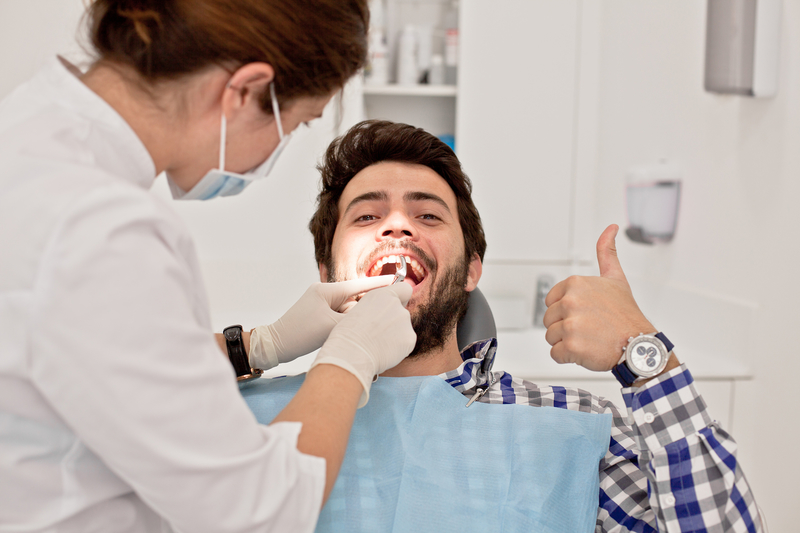
Dentists and orthodontists are both highly-trained professionals that can transform your smile. However, they provide completely different services to patients and both may be needed to help get your smile as healthy as possible. Orthodontic treatment connects to dentistry in many ways, as do the professionals themselves. If you’re like many others, you may need both professionals to keep your oral health in check.
Your Oral Care
Did you know that your oral health can affect all other aspects of your health? This is especially true if you already have some chronic conditions such as diabetes and heart disease. If your oral health isn’t taken care of, your overall health can worse and you are more susceptible to infection. If you don’t control chronic conditions, your oral health can worsen, as the blood vessels that nourish your teeth and gums can become damaged. Your teeth are more likely to decay and get infections that lead to tooth loss.
That is why taking care of your oral health is so important. It can help determine the state of your overall health and if you keep your teeth for a few years or for many. Many people need both an orthodontist and a dentist to help keep their mouth healthy. Not everyone needs an orthodontist alongside their dental care, but millions do. At least 4 million are getting braces each year in the United States alone to correct bite, alignment and problems with the teeth that lead to oral health diseases. When oral health care is happening at home, yet gum disease tooth decay continue to happen, it’s time to also seek help from an orthodontist.
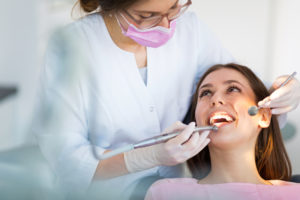
How Can a Dentist Help You?
A dentist is a professional that every person needs. Dentists are vital to you having good oral health for life. They can detect the presence of tooth decay, gum disease, oral cancer, oral sores and any other oral problem, plus they do the work to help correct those issues. These professionals go to school for 10 years just learning about your mouth and facial structures so they can help you stay healthy. Orthodontists receive all that same training, plus 2-3 extra years learning about straightening teeth, bite and alignment issues and structural problems with the mouth.
Because these professionals do different work, you will probably need both. Dentists have the primary duty to find the presence of tooth decay (cavities) using digital and x-ray technology. Then they have many different procedures to remove decay, fill the cavity, and restore your smile. They can do cosmetic work to make your smile look better and they deal primarily with oral health diseases and helping you avoid them so you don’t have early tooth loss. Orthodontists are trained to see cavities and oral health issues, but they will do structural work to help change your smile instead of dealing with the disease aspect of your oral health. Their work focuses on prevention of those issues in the first place.
How Can an Orthodontist Help You?
Did you know that people have had orthodontic care at least since the time of the Ancient Egyptians? More discoveries are finding orthodontic appliances on teeth thousands of years ago. Why? Because people that long ago also understood the benefits of straighter teeth. It took many centuries for orthodontists and orthodontic work to become established.
Studies found that straighter teeth made dental issues less likely to happen. When patients received orthodontic straightening—even through crude methods—they were less likely to have their teeth decay or break and less likely to have gum issues. The same holds true today. Crooked teeth are teeth that are much harder to clean. In a straight, even bite, the top front teeth rest just slightly in front of the bottom front teeth. From the front to the back, the teeth rest evenly on one another, evening out pressure from biting, chewing, eating, talking and more.
When the teeth are crooked, patients will get areas where they simply can’t get a toothbrush or floss to and those areas decay. The teeth may be at odd angles, and with uneven pressure placed on those teeth all the time, they may simply break. If you have crooked teeth, an orthodontist can easily make a plan to straighten them. Using digital x-rays, an orthodontist can examine your bite, alignment and incoming teeth and can make a plan to ensure all your teeth line up for the best oral health you could have.
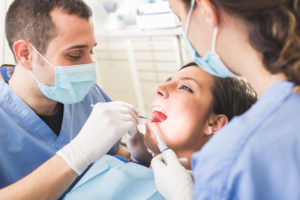
Do You Need an Orthodontist?
Not everyone will need an orthodontist, but their care can benefit most people. Even getting slight straightening of the teeth can reduce your dental breaks, emergencies and issues with oral health diseases. Orthodontic care can even help with bad breath if that stems from plaque and bacteria in the mouth that you can’t quite get rid of. To know for sure if you need an orthodontist, make sure to schedule an examination.
For children, the national recommendation by groups such as the American Association of Orthodontics is to visit an orthodontist around age 7 or 8. This is a key time for an orthodontist to be able to tell if the incoming adult teeth are coming in at the correct angle and place in the mouth. Oral health issues that can become severe later on in life can be caught early and childhood and many oral problems can be prevented with some orthodontic care. For all other issues with finding and filling cavities, gum disease, sores and more, make sure to call your dentist. To schedule your consultation with the orthodontist, call Belmar Orthodontics today at (303) 225-9016!
Be Thankful for Orthodontic Treatment

Studies show that not enough Americans are taking good care of their teeth, especially through dental and orthodontic treatment. The advanced technology available today is what allows patients to keep their natural teeth healthy for life and is something that millions in the world don’t have access to. Find out why oral health services such as orthodontic treatment is so important to patients and something to be thankful for this time of year!
Your Oral Health
When you think of the most chronic conditions and diseases that plague people today, you may not think of cavities as being one of the them. The National Institutes of Health reports that tooth decay—or cavities—are the most “chronic, prevalent disease” among American children and adults. In fact, about 92% of people have tooth decay by the time they reach adulthood. In all age groups, roughly between 20% and 25% of people have untreated decay they are not aware of.
What does tooth decay have to do with orthodontic treatment? This decay can happen to anyone at anytime and you are more likely to have tooth decay during your orthodontic treatment. Many patients opt for lingual, ceramic or traditional metal braces to straighten their teeth. These methods require brackets that are bonded to the teeth with wires that pass through those brackets. Even though these appliances are highly effective for providing beautiful straightening power, they can make it harder to clean your teeth. Because it’s harder to clean them, and some patients don’t take the extra time to do this, you can end up with tooth decay. That adds to that 92% statistic.
The best way to eliminate your risk for that tooth decay (as well as other oral health diseases), is to properly care for your teeth both with and without braces. That involves brushing your teeth at least twice a day for 2 minutes at a time, as recommended by the American Dental Association. When you have braces, you have to do this after every meal to avoid acidic plaque buildup, which happens when your food and drink sugars mix with mouth bacteria. With braces, threadable floss to go around brackets and wires is generally needed, as well as cleaning items such as a waterpik (water shooter) tool and a proxabrush for brackets. Your oral health can be stellar during orthodontic treatment with the right oral hygiene.

How Does the U.S. Compare?
Orthodontic treatment is a time when those in the U.S. can have a greater risk for developing cavities. This comes from a lack of oral hygiene during your orthodontic treatment period. However, the world at large is battling oral health diseases and poor dental and orthodontic care on an epidemic scale. The World Health Organization reports that cavities (tooth decay) and gum disease (periodontal disease) “have historically been considered the most important global oral health burdens”.
60%-90% of people worldwide have tooth decay and oral diseases connected to this condition. Children are affected the most, but statistics are almost as high in adults worldwide. Even though the U.S. is at a high percentage when it comes to tooth decay (92%), the presence of tooth decay is generally eliminated in most of the population through proper dental work and access to dental services. In the majority of other countries—especially underdeveloped ones—dental or orthodontic work is not a possibility for most. Oral health diseases are simply left untreated or the teeth are pulled when they become too painful.
The Connection to Orthodontic Treatment
Getting a cavity or having an oral health problem during your life can definitely be avoided, but most people will have some sort of oral problem, even if it is small. There are ways to prevent those problems such as proper brushing and flossing every single day. A great way to reduce your risk for oral health diseases is through orthodontic treatment. For children, this is known as child orthodontics. The American Association of Orthodontics recommends that children have their first orthodontic appointment between age 7 or 8.
This is a time when baby teeth are starting to fall out and adult, permanent teeth are starting to come into the mouth. Proper examination by an orthodontist can sport bite and alignment issues that are developing in children. When these issues occur, the teeth can come in crooked all over or they may not rest in the position they are supposed to. This can lead to speech impediments, many dental emergencies and broken teeth in the future from uneven dental pressure, higher instances of tooth decay and gum disease, and problems with oral health diseases.
Orthodontic treatment when young can help align the teeth and jaws to prevent oral problems as a child grows. When teens and adults receive orthodontic treatment via braces, they can better straighten permanent teeth when they come in. This sets everything straight and functional before the jaws harden in adulthood. Straight teeth and aligned jaws make it so cleaning the teeth becomes almost effortless. The risk for tooth decay and gum disease is also significantly lower.

Be Thankful for Your Orthodontic Treatment
Dentistry and orthodontic treatment helps diminish the presence of oral diseases.Yes, tooth decay and gum disease happen frequently due to poor oral hygiene habits. However, orthodontic treatment can help prevent those problems in the first place. Great oral care can prevent developing problems throughout your life. Even when these issues do happen, you won’t have to simply get your teeth pulled or let them decay and fall out of your mouth.
You have great orthodontic and dental options in the United States that allow you to keep your teeth, while many people across the globe have to lose them. Remember that the next time you think about skipping your oral care appointments. To reduce your risk for oral health diseases, you can call Belmar Orthodontics at (303) 225-9016 and ask about your orthodontic treatment plan.
Braces Can Change Your Life
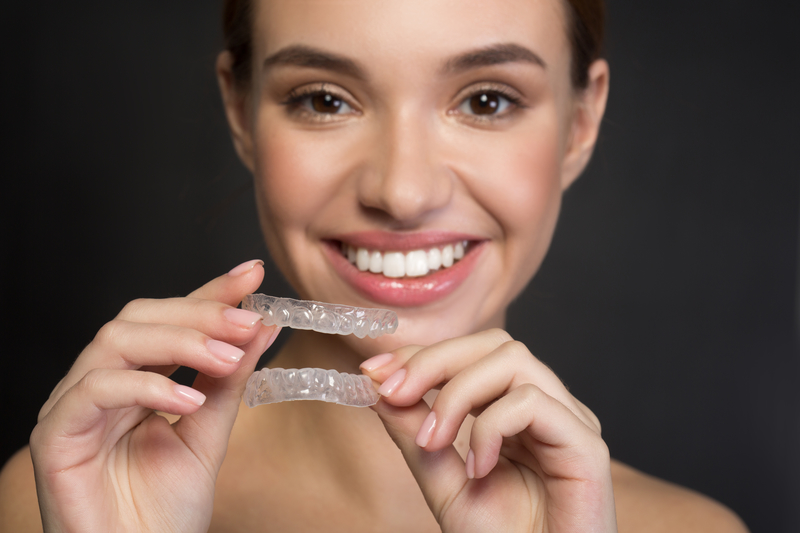
Your oral health can determine much of your overall health. Food and substances enter through your mouth, affecting your waistline, your appearance and your health. Your oral health can improve your overall health when you make changes in oral hygiene and bite and alignment. Misalignments in bites and crooked teeth can cause health and social problems, as they can lead to speech impediments, oral health diseases, and worsening chronic conditions. With braces, you can not only change how healthy your mouth is, but can change your life too!
Growing In Straight Teeth
Many people picture teens when they think of braces. However, 1/4th of people with braces are kids. Child orthodontics help straighten out teeth that would cause them speech problems, broken teeth and trouble growing in the permanent teeth. Adults and teens usually get them for crooked teeth.
However, braces aren’t just for people with crooked teeth. You may see patients young and old that appear to have a straight smile and yet they have to get braces. In this case, there is probably an oral health issue with the bite or alignment. Your teeth should line up along both the upper jaw and the lower jaw. When you go to the dentist, they will ask you to bite together so that they can view how your bite rests. How your teeth sit when they are resting together can determine if you will have dental issues and even speech impediments. This is especially true for young kids who are losing baby teeth and having adult teeth grow in.
Children have their baby teeth for years—even up to age 12 or later at times. Those baby teeth start to space out a bit more as a child grows from an infant to a school-aged child. Their mouth grows with them, making room for adult teeth. 20 baby teeth will become 32 adult teeth (including the wisdom teeth). However, those teeth don’t always come into the mouth in the right position or the right direction. With a healthy bite, the upper and lower jaws should have the teeth lining up evenly with one another. The teeth should be straight up and down, and the front upper teeth will rest just slightly in front of the bottom front teeth.
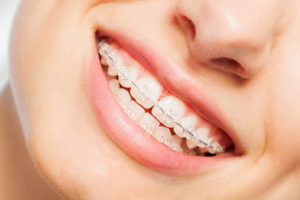
Braces Can Prevent Dental Injuries
When teeth aren’t straight and they jut out at different angles, it can mean broken, cracked or chipped teeth in the future. Those dental injuries would be caused by uneven pressure on certain teeth which will eventually break them or will cause areas of decay that you can’t clean well. The alignment of the teeth can also cause speech impediments when forming words, and those impediments can last for life if bite, alignment and crooked teeth aren’t corrected. For young children and adults alike, receiving braces for these issues can certainly change not only their oral health, but their life.
Braces are sometimes needed to make space in a patient’s mouth. Not all mouths grow to fit the incoming teeth, but that doesn’t mean the adult teeth won’t stop coming in. All your teeth will come in, even if they have to crowd out other teeth. That crowding can be painful and even one tooth coming in where there isn’t room can cause all of your teeth to go crooked. As a tooth comes in, it will slowly push other teeth from the area, which then have to shift. This is what wisdom teeth commonly do, and it can be painful as it messes up a smile. Braces can stop that from happening by making plenty of space in the mouth for teeth that are still coming in.
What If You Have Your Teeth Already?
The dental issues we have mentioned will generally happen before a person has reached adulthood. The American Association of Orthodontics recommends that children have their first orthodontic appointment around age 7 or 8. This is when we can see how the baby teeth are falling out and how the permanent teeth are coming in. We stop dental issues before they start forming, and during this time when the jaw bones are still soft enough to mold. However, at least 1/4th of patients that have braces get them when they are adults. The jaws have grow completely and have hardened into place by adulthood, making orthodontic treatment harder.
However, we said “harder”, not “impossible”. Orthodontic advancements can definitely help an adult change their smile to change their life. Now, more than ever, it is becoming increasingly important to have a straight smile as an adult. Studies show that others make an opinion of you based off of the first few seconds of meeting you. Your appearance can go a long way. Your smile is also one of the top 3 features others will notice first when formulating an opinion about you. Studies show that those with straighter teeth are seen as more attractive, successful, smart, healthy and trustworthy. Employers are more likely to hire those with straight smiles over those who don’t have them.

Your Options
If you’re an adult, you can straighten your smile without it being noticeable. Children often go the route of traditional metal braces or ceramic braces, which are the same but made from ceramic material. Adults and many teens opt for hidden options like lingual braces or Invisalign treatment. Lingual braces are metal braces that attach behind the teeth, staying hidden as they correct bite, alignment and your teeth. Invisalign treatment consists of transparent aligners patients change out every week. However, they don’t do as well with larger bite and alignment issues. It’s never too late to receive orthodontic treatment.
Whether you are young or old, you can change your smile to reduce or eliminate your problems with speech, tooth decay, oral health issues, dental injuries and to even feel more attractive. Want to see just how much braces can change your life? Call Belmar Orthodontics today at (303) 225-9016 to receive your free consultation!
Avoid These Sweet Treats at Halloween with Braces

Halloween can be an incredibly fun time for kids and adults alike. However, the not-so-fun part is developing cavities later on because of that Halloween candy. Sugar is directly related to tooth decay, but it’s even worse if you have braces on your teeth. There are specific candies you should try to avoid if you have brackets and wires, as they can get stuck easier. Find out what these are and tips to reduce your risk for tooth decay during the holidays!
How Popular Is Halloween?
About $2.4 billion dollars is spent in Easter candy each year. However, Halloween candy is a close second at around $2.1 billion in sales. Divided up into individual households, that’s about $44-$47 dollars spent on Halloween candy in each household.
If you think Halloween candy sales are scary, here are the facts on the actual candy consumed on Halloween day itself:
- Almost all children and at least ½ of all adults eat candy on Halloween day.
- However, the amount of candy consumed is well-past the recommended 6 or less teaspoons children should have in a day. Adults should only have between 6 and 9 teaspoons of sugar (tops) per day. On Halloween itself, up to 3 cups of candy is consumed per child.
- That equates to about 48 teaspoons of sugar per cup, or about 144 teaspoons of sugar, or 675 grams of sugar in one day.
- USA Today reports that 4% of all the candy eaten in the U.S. is eaten on Halloween day.
- Reader’s Digest reports that the amount of calories children and adults alike eat on Halloween equals anywhere between 3,000 and 7,000 calories.
- Not only can this much sugar lead to incredible health problems and diabetes, but sugar—the main ingredient in that candy—is the direct cause of tooth decay.

How Can Candy Hurt Your Teeth?
Candy is damaging to your teeth because of the sugar, which is a direct factor in your risk for tooth decay. The more sugar you eat, the more cavities you could get. When you eat or drink, sugars in food will mix with certain bacterias in your mouth. That mixture will create a sticky substance called plaque. You can’t simply swallow that plaque either. It sticks to your teeth and becomes an acidic substance when it mixes.
Because it’s acidic, as it sticks to your tooth enamel like a film, it will work to erode and decay your teeth. It does this by breaking up the minerals that make up your tooth enamel layer. If you don’t brush and floss your teeth often enough, or you eat a ton of sugar, you have plaque working hard on your teeth to destroy them.
Plaque can decay your tooth surface to create surface cavities. If enough decay happens on that layer, it can get through to the inner layers of the teeth, causing internal (and sometimes large) cavities that can turn into infections and tooth loss. Sugar is the main food for plaque, which is why candy—whose main ingredient is sugar—can hurt your teeth.
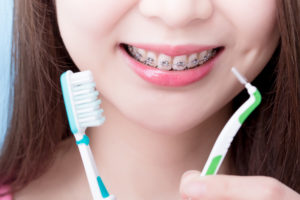
Avoiding Specific Sweet Treats with Braces
Anyone can get cavities and other oral health problems from a large candy or sugar consumption. You don’t only have to worry about candy either when it comes to cavities—you have to worry about all foods. Most foods you can buy at the store have added sugars in them. That includes juices, sports drinks, and sodas, as well as the obvious sugar foods like candy, cakes, ice cream and cookies. Always check food labels to see how much sugar a food contains.
There are specific foods you want to avoid if you wear braces, as those foods and candies can make it much easier for you to get cavities. Especially at Halloween, popular candies are ones that are chewy and sticky. Anything chewy and sticky will get stuck in your brackets and wires if you wear lingual, ceramic or metal braces. Sweet treats you want to avoid if you wear braces include:
- Gum: Gum is made to be elastic and sticky and can stick to brackets like crazy. Avoid it completely with braces. After your braces are off, chew sugar-free gum.
- Chewy/Sticky Candy: Examples include caramels, taffy, Tootsie Rolls, Starburst, licorice, Skittles, Sugar Daddies and any candies that are similar. Avoid fruit snacks, gummies and dried fruit as well, which are all incredibly sticky.
- Hard Candies: These go hand-in-hand with suckers and mints. All of these candies expose your teeth to sugars for prolonged periods of time, which means a prolonged risk for acidic plaque and tooth decay.
- Sodas/Citrus Drinks: These and any carbonated drinks all contain either citric acid or carbonic acid, which erode the teeth. That can mean you have tooth erosion and decay all around your brackets, which will be very noticeable when your braces come off.
Enjoy Some Sweetness This Halloween
When it comes to Halloween, we want all of our patients to have fun and to enjoy the holiday. Candy is naturally a part of that holiday, but it doesn’t mean that you have to experience tooth decay in the weeks following it. Every person needs to be conscious of their candy consumption on Halloween to avoid tooth decay, erosion and health problems in general.
You don’t want to work hard for 18-24 months getting a straight smile if it’s decayed when your braces finally come off. Enjoy your Halloween sweet treats, but be mindful of your oral health. Brush your teeth 3 times a day or after every meal with fluoride toothpaste. Floss your teeth at least 1-2 times a day. Avoid sticky and sugary treats and clean the teeth very well if you do eat them at Halloween. Avoid acidic drinks and watch your sugar consumption. For tips on cleaning your teeth correctly with braces to avoid tooth decay, call Belmar Orthodontics today at (303) 225-9016!
Orthodontic Treatment as Restorative Dentistry

Did you know that getting your teeth straightened can be a form of restorative dentistry? This is because restorative dentistry seeks to restore or bring your smile to a more perfect state. Crooked teeth can become straight, which in turn starts to relieve the burdens of tooth decay, gum disease, bad breath and other oral health problems. If you want to restore your smile once more, see what our 4 different orthodontic options can do for you!
Why Is Your Smile Important?
Some patients don’t realize just how important a smile really is. Studies show that your smile is one of the first things another person will notice about you. Is that smile showing that you are healthy and confident? Or do you hide your smile because of crooked teeth, discoloration or other aspects you don’t like? When a smile looks good, studies show that people often feel more confident and they exude that confidence much easier. A better smile can lead a person to be more social and confident to pursue successful endeavors.
It’s not only what a smile does for a person themself that’s important. How your smile looks to others also will determine a lot about how successful you are. The makes of the orthodontic appliance Invisalign conducted a study about smiles, and what they found was quite amazing:
- 1/3rd of people notice a person’s smile before any other feature.
- Those who have a straighter, more beautiful smile are 45% more likely to get a job over a competitor with a crooked or discolored smile.
- Your smile can send messages about how healthy you are and how happy you seem. When that smile is straighter and more beautiful, others will see you as 21% more likely to be healthier and 47% happier.
- 73% of people are more likely to trust you at first glance if you have a better smile.
- You’re 58% more likely to be perceived as wealthy and 57% more likely to get a date if you have a great smile.

What Is Restorative Dentistry?
Your teeth will determine most of how good your oral health. When you eat, sugars in the food you eat mix with mouth bacteria. That creates plaque, or that sticky, acidic substance that coats your teeth. Over time, if proper oral hygiene habits aren’t observed, the teeth will change colors and decay. This happens much easier to the teeth if they are crooked. That’s because it’s harder to clean between the teeth if there is no way to get floss through crooked teeth.
Restorative dentistry seeks to restore smiles that are crooked or damaged through decay or gum disease (a disease to the gums that happens just like tooth decay). This form of dentistry consists of dental services such as teeth whitening, same-day crowns, root canal therapy and tooth-colored fillings. There are many dental patients that will get dental veneers—also known as “porcelain veneers”—to restore their smile. This is a dental service where the top layer of your teeth is taken off and replaced with a perfect, white tooth shell. However, once that part of your natural tooth is taken off, you can’t get that natural part back. Porcelain veneers do make your smile look beautiful, but they don’t change your crooked teeth or oral health issues underneath.
Fixing the Problem with Orthodontic Treatment
Fixing the problem permanently is a great solution to getting a beautiful smile and reducing your problems with tooth decay, gum disease, bad breath and more. Straighter smiles are ones that are easier to clean and ones that look attractive and healthy. Plus, once you straighten your smile with orthodontic treatment, it can stay that way for life. Orthodontics is different than dentistry, but is absolutely important to your oral health.
Dentists will fix problems with tooth decay and gum disease. Orthodontic treatment and restorative dentistry through those braces can help prevent problems in the first place. Plus, orthodontic braces are able to correct bite and alignment issues that are caused by misaligned bites and jaws. Those issues can cause speech and development problems without intervention. Without orthodontic treatment, other restorative dentistry methods can only do so much.
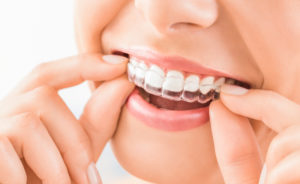
Restorative Dentistry for You
Our easiest method of restorative dentistry for teens and adults is through Invisalign treatment. This option works just as well as our lingual braces, ceramic braces and traditional metal braces. However, with Invisalign, the focus is on aesthetics as well as straightening. We want you to have a beautiful smile as you straighten, and Invisalign is a great way to achieve that.
Invisalign is a orthodontic treatment that is designed to be virtually unnoticeable on your teeth. Patients have their teeth digitally scanned in-office and a treatment plan is made for them, mapping out how orthodontic treatment will transform their smile in 18 months or less. Often, patients can straighten their smile in 1/3rd of that time, depending on the condition of the teeth, bite and alignment. Less office visits are typically needed for this type of restorative dentistry.
You simply wear your aligners for 20-22 hours each day (and overnight), and by switching out the aligners each week, your teeth shift into a straight smile over time. The benefit of this restorative dentistry option is that you are actually fixing the root cause of oral health problems. Crooked teeth cause tooth decay and gum disease to worsen, but you avoid that with a straight smile. With other restorative dentistry options (such as teeth whitening or veneers), you will still have the crooked teeth (although masked), and possibly the dental problems. Avoid all that while still getting a beautiful smile with Invisalign. If you want to learn more about this restorative dentistry option for adults and teens, contact Belmar Orthodontics today at (303) 225-9016!
Preventing Cavities During Braces
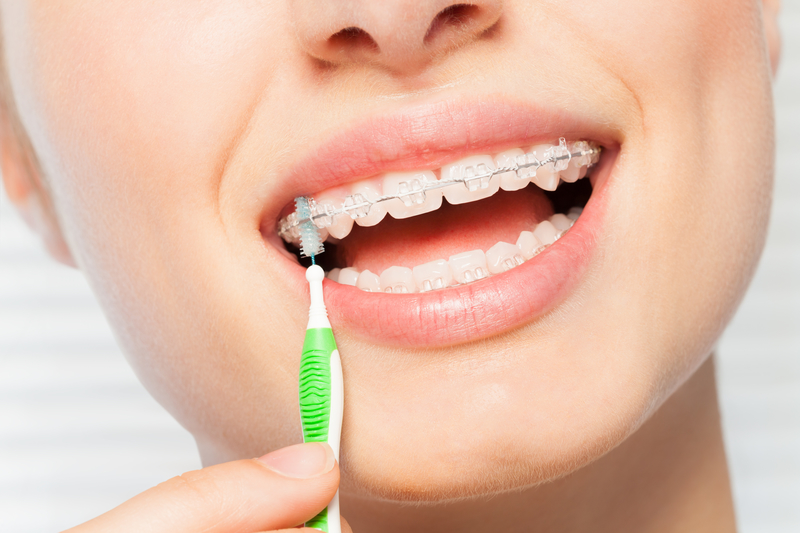
Braces is an exciting time for getting that straight smile you’ve always wanted. The not-so-exciting part about braces though, is that they give you a greater risk for cavities. Because there are appliances attached to your teeth, they can become havens for bacteria and plaque buildup. Proper oral hygiene, avoiding certain foods can help you prevent cavities during your time with braces!
Your First Orthodontic Appointment
Finding cavities before you get braces is key to ensuring that you have a healthy smile before getting brackets and wires on your teeth. With braces, you will meet often with your orthodontist to have your braces adjusted. However, you still need to go to your dental appointments to make sure you don’t have cavities during braces.
Traditional metal braces, ceramic braces and lingual braces all have brackets and wires that go on your teeth. Before you get fitted for these braces, you will have dental x-rays taken by the dentist to detect cavities. It’s very important to get your exam so tooth decay is detected. Otherwise, you could end up with large cavities during braces. If cavities are found, they must be fixed before we put your braces on.
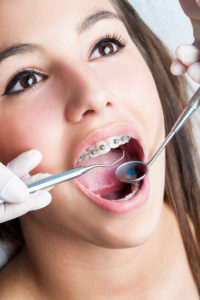
Oral Hygiene Is a Must
The status of your smile and your oral health will depend on what you do once you get your braces. The American Dental Association recommends brushing your teeth at least twice a day and flossing 1-2 times. That recommendation is for patients who don’t have braces. When you have braces, you have to be extra meticulous with oral hygiene practices and you will have to do them more than you used to. That means, brushing after every single meal if you can.
To avoid cavities during braces:
- Brush your teeth after every meal. Use a soft-bristled toothbrush with fluoride toothpaste, and brush for 2 minutes every time, making sure to go in all different directions to dislodge food.
- Floss your teeth. This is a habit many people skip with braces because it takes a bit more time. However, it’s time well spent. Floss at least twice a day, using threadable floss. This kind of floss allows you to thread it through the spaces between your teeth, pulling it through so you can floss like normal. It makes flossing a breeze and helps prevent cavities during braces.
- Use orthodontic cleaning tools. A waterpik is a great water-spraying tool that can help you dislodge stuck food. A braces brush (that looks like a Christmas tree brush) can get food out of brackets.
- Watch what you eat! More sugar means more cavities during braces. Limit how much sugar you eat. You want to avoid sticky, sugary foods such as taffy, Starbursts, dried fruit, gummies, fruit snacks, caramels, and anything similar.
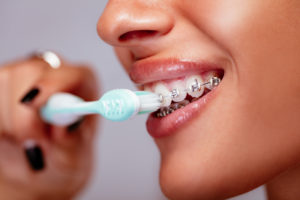
Developing Cavities During Braces
Sometimes, tooth enamel is simply weak and tooth decay happens, despite all your hard effort to avoid cavities. When you eat, sugars in your food mixes with mouth bacteria to create plaque. That plaque sticks to your teeth and slowly eats it away, creating decay. You only need plaque stuck in the right place to develop cavities during braces. When you have hidden tooth decay, you may start to feel symptoms such as a toothache, tooth sensitivity or pains with hot and cold. When you see these signs, get dental x-rays taken to see if you have cavities during braces.
If there is a cavity, you actually can have it fixed even if you have braces. It all depends on where the decay is. In most cases, cavities during braces can be fixed because many will lie on surfaces not covered with brackets or wires. You would have the decay drilled out and filled as you normally would. However, if you have a band on your teeth or brackets and wires right where decay is, we would have to remove the bracket or wire while you get it fixed at the dental office. We would then have you come back to our office to get your dental appliance reattached. Patients can sometimes develop such severe cavities during braces that they will need root canals. However, if you are taking care of your teeth, you won’t ever have to worry about that.
Best Option to Avoid Cavities
If you are worried about cavities during braces or have seen a family member get cavities during braces, then getting braces might make you nervous. However, no matter what braces option you choose, the benefits of a straight, beautiful smile can last a lifetime. It’s definitely worth it to get braces; you will just have to be careful to take care of them. If cavities during braces are a concern, consider the benefits of using Invisalign aligners. This is one of our most popular orthodontic options for teens and adults because it is a hidden option for straightening your teeth.
Invisalign transparent aligners are a series of custom-made aligners (like retainers) that fit incredibly snug to your teeth. We take digital calculations of your mouth, where we then design transparent aligners around the shape of your teeth and where we want them to be 18-24 months from that time. Each week, you will switch to a new aligner, which will slowly put pressure on different areas of your mouth, shaping the teeth into a straight line. The aligners are clear and designed to be virtually unnoticeable on your teeth.
When it comes to cavities during braces, you are the one that decides if you will get them with this orthodontic option. That’s because that are completely removable for eating, drinking, flossing and brushing your teeth. It takes less time to brush and floss because of this and there are no appliances on your teeth. This can reduce your risk for cavities during braces, especially if you already know that you have weak tooth enamel. For any questions about cavities during braces, call Belmar Orthodontics at (303) 225-9016!
Be Vigilant with Your Child’s Oral Health
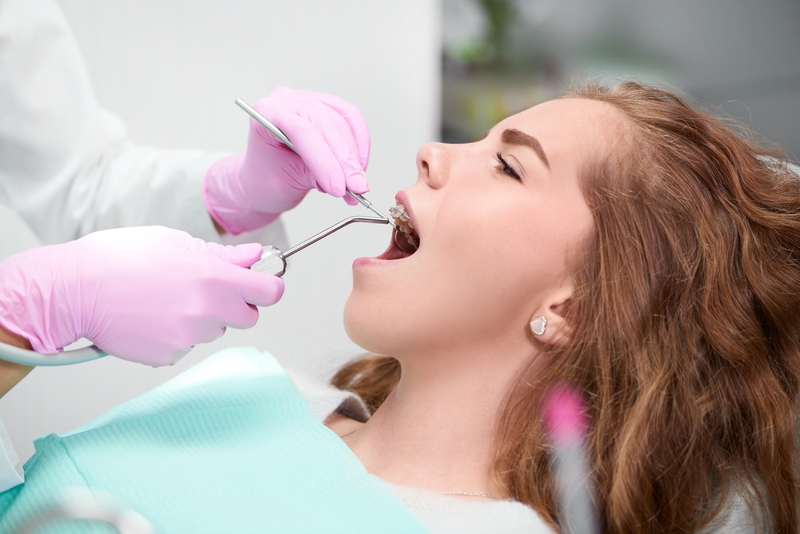
More than half the people that wear braces are children and teens. This can be an exciting time for kids to fix bite problems and crooked teeth. However, tooth decay and oral health problems also run rampant during braces if oral hygiene guidelines aren’t followed. Sometimes children and teens need a nudge to help them with their oral health. Find out what they should be doing to care for their braces during this time!
Facts About Braces
Did you know that there are over 4 million people in the United States each year that wear braces? About 1/4th of those are adults and the rest are children and teens. Patients use braces as teens to straighten the adult, permanent teeth that have come in. When children have child orthodontics, those brackets and wires are meant to correct bite and alignment issues that could cause a child severe problems in the future. Children can then straighten their permanent teeth later on.
There are common oral health problems that many children face today. It’s called tooth decay, and the National Institutes of Health reports that it’s the most “prevalent, chronic disease” among children and adults. 42% of children will have tooth decay before they are 12. 23% of those will have untreated dental decay. About 92% of adults have had tooth decay sometime in their life. The worst part about this is that tooth decay is completely preventable if a child, teen or adult has good oral health through practicing proper oral hygiene.
It may take several years for a child to have the right dexterity in their hands to brush and floss correctly. That is why parents must take care of their child’s oral health when they are young, or it could lead to serious problems. Children rely on parents to help their mouth stay healthy. Even teens need to be told to brush and floss, as it’s something they often forget. These habits are especially important during braces, as oral health is most affected when there are brackets and wires on the teeth.
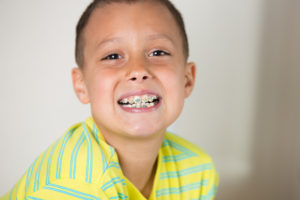
Helping Your Child’s Oral Health
The American Academy of Pediatrics recommends that children see a dentist around 1 year or within 6 months of their first tooth coming in. After that, they should go biannually to the dentist. This is how a dentist can start to see signs of bite and alignment problems, which are then referred to an orthodontist.
With some orthodontic appointments, a child can be fitted for braces to correct problems that are easy to fix with a young, moldable jaw, but hard to fix when a person is older and their jaws are set. Without braces, you will have to help your child brush and floss their teeth at least twice a day as the American Dental Association recommends. Use child toothpaste enhanced with decay-fighting fluoride and a toothbrush that fits the size of your child’s mouth.
Children will need to floss between their teeth, but might have to start out with flossers for kids. With braces, children should be brushing at least twice a day, but after every meal is even better. They should brush at 45-degree angles, making sure to move in all different directions to dislodge food that has been stuck in the braces. Flossing is incredibly important as well, as it gets 40% of tooth surfaces that are missed if flossing is skipped. Help them learn how to use threadable floss. This gets poked through the spaces between their teeth, pulled through, and flossed like you would normally do. Use a Christmas tree brush or a waterpik to help them dislodge stuck food.
Do You Have Good Habits?
One of the best ways to help your child with their oral health is to show them its importance through your own actions. If you don’t brush and floss your teeth, your child or teen may not either. When you’re also not visiting the dentist, odds are that your child isn’t either. If you eat a poor diet full of sugar, then your child will do the same. Children often copy what their parents do.
Make sure you are brushing your teeth at least twice a day, especially when your children can see you. Floss your teeth and teach them how to floss properly as well. When you need to go to the dentist, take your children with you and have them get their comprehensive exams and cleanings. All these oral health measures will ensure their mouths stay clean and healthy for years!
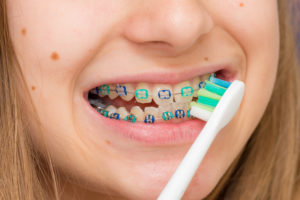
Other Factors to Consider
Your child can brush and floss their teeth often and may still end up with cavities. Cavities come from plaque in the mouth that has set on the teeth for too long. Your mouth makes plaque when you eat sugary foods and that sugar mixes with mouth bacteria to make acidic plaque. That acid is what causes the tooth decay. However, if you limit your sugar intake to begin with, you won’t have the problem with tooth decay.
Unfortunately, sugar is one of the most-consumed substances in the world. It is literally found in almost every food. That is why tooth decay is so common, especially in children. Limit your child’s sugar intake if you want them to have healthy teeth when their braces come off. Teeth that don’t get brushed or flossed often with braces, may end up having cavities, gum disease and eroded areas of their teeth when braces come off.
Their food can also leave them with squares on their teeth from the brackets, because the surrounding tooth has been damaged by food. Make sure to consider what your child is putting in their mouth if you want to help them have good oral health! For more tips or answers to questions about your child’s braces, call Belmar Orthodontics today at (303) 225-9016!
Cavity Treatment During Braces
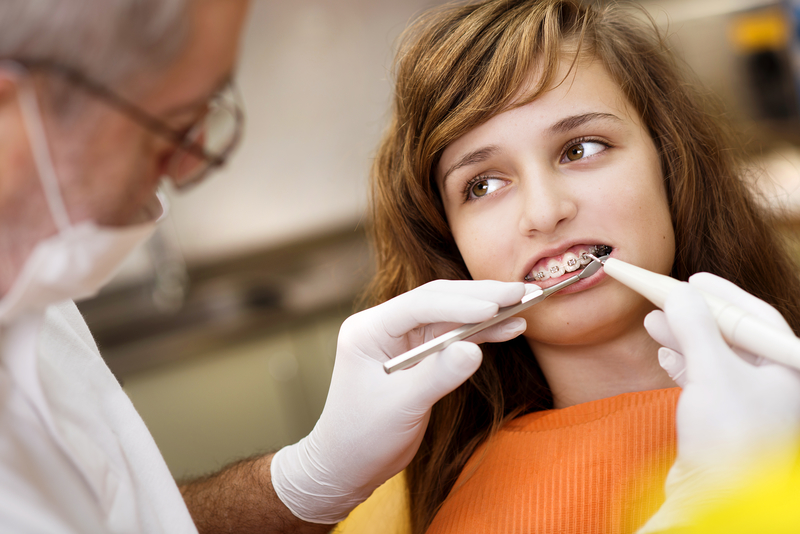
Did you know that an orthodontist and a dentist are not the same? Only a dentist can help with cavities, gum disease and more, while only an orthodontist can straighten your teeth in a certain way. A patient’s time with braces is a time when cavities happen very quickly, because the teeth are harder to clean. To prevent cavities during your time with braces, it is vital that you continue to see a dentist. If you do happen to get a cavity, find out what that cavity treatment will look like!
Proper Oral Hygiene
The American Dental Association recommends that every patient brush their teeth at least twice a day to avoid tooth decay. Brushing after every meal is even better for avoiding plaque buildup that leads to decay. Every patient should also floss their teeth at least once a day. Using fluoride toothpaste is best, because fluoride helps coat the teeth in a protective layer that prevents decay and keeps tooth enamel stronger. Patients can also benefit from mouthwash, as it can kill bacteria that would otherwise create plaque.
However, these recommendations are for people that don’t have braces. Every single person—children, teens and adults—should follow these recommendations. Infants should not use fluoride or mouthwash, but their child toothpastes generally have safe amounts of fluoride in them. If you are a patient that is receiving orthodontic care via braces, you have to go the extra mile with your oral hygiene. That means more frequent brushing, more flossing and watching what you eat.
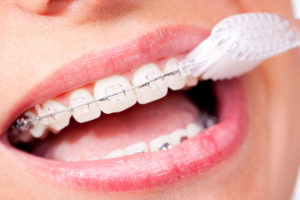
Taking Care of Braces
Braces can be tricky to clean. However, their design provides the best and quickest way for you to straighten your teeth, which is why traditional metal braces have been around for so many decades. Metal braces, ceramic braces and lingual braces all have a brackets-and-wires design.
However, with braces, you must be meticulous with cleaning them or you will have food and plaque get stuck places. If you don’t unstick those substances, they will quickly erode your tooth enamel and cause decay around your appliances. This can happen on every tooth as well.
Follow these tips for cleaning your braces:
- Brush after every single meal. This reduces staining and bacteria buildup. Use a regular soft-bristled brush and brush down from the top, then up from the bottom. Brush in all different directions to dislodge food.
- Use a threadable floss or a floss threader. Both will require that you thread the floss through each space between your teeth. You will have to go under the wire to do this, and it will take slightly longer than normal flossing. This is one of the most important oral hygiene recommendations to follow!
- Use helpful tools. A proxabrush is a small braces brush that can help unstick foods. It looks like a tiny Christmas Tree brush. A waterpik is also helpful. This is a tool that helps blast away food particles with a stream of water.
Tooth Decay with Braces
Many children and teens skip flossing or brushing here and there. Every time you skip on an oral hygiene habit, it increases your risk for tooth decay—or cavities—with braces. Your time with braces is one where you have to be super careful about your oral health. Most people picture their beautiful smile after getting their braces off, but they don’t think about cavities and tooth erosion. You can end up with tooth decay and parts of your teeth that have eroded due to your oral hygiene habits with braces.
Nobody wants to spend 18-24 months perfecting their teeth only to be disappointed in their smile. That’s why oral hygiene is so important. Tooth decay happens rapidly, and it can happen where the brackets are bonded to your teeth and in-between your teeth because it is harder to floss. Normally, you would simply visit the dentist and have your cavity removed and filled. However, cavity treatment is a bit different with braces.
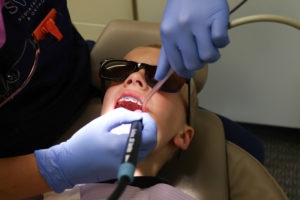
Cavity Treatment with Braces
Cavity treatment is slightly harder if you have braces, but not impossible. Generally, decay happens between teeth cracks and around brackets and wires. If you have tooth decay that is in a tricky spot, we can remove your wire so that a dentist can provide you with a proper cavity treatment. You will have to have your appointments scheduled close together (dentist and orthodontist) so that you can get your cavity filled and your wire replaced.
In severe cases of tooth decay, we may have to remove a bracket from the tooth if it interferes with the dental work that needs to be done. We only do this in certain cases, and we replace the missing part as soon as possible so your teeth don’t move. Cavity treatment—with taking out the tooth decay and filling it—is the same with braces as it is without, only you have to work around orthodontic appliances if you have braces. Always let us know if you have tooth sensitivity, sharp (and even mild) pain when chewing and if you have sensitivity to hot or cold foods. This signals that there may be a more severe cavity.
Prevent Cavity Treatment
The goal of every patient—old and young—is to avoid tooth decay altogether. If you do, you’ll never have to worry about cavity treatment with braces. If your decay is small and in a tricky spot, you may have to wait until your braces are off to receive your cavity treatment. That might make your cavity grow larger, which is something you don’t want. Always see the dentist to check your mouth for tooth decay before you receive orthodontic treatment. This can avoid many problems in the future.
If you are prone to getting cavities or you have weak enamel, consider receiving Invisalign treatment instead of getting brackets and wires. This will help you avoid problems with cavities and needing to get cavity treatment. If you have tooth pain or want to learn more about cavity treatment with braces, call Belmar Orthodontics today at (303) 225-9016!
Sugar Guidelines for Children and Adults

Did you know that the more sugar you eat, the more at-risk you are for cavities? Sugar itself doesn’t necessarily cause a an immediate cavity, but you do get tooth decay because of the effects of sugar on your teeth. That is why it’s so important to brush and floss your teeth every day and to keep your mouth clean. You may be watching your sugar intake, not realizing that you are still going over recommended sugar guidelines. Even diet or “healthy” foods are full of sugar in many cases, which means you might be at a higher risk for tooth decay than you think. Find out what the sugar guidelines are for each age group, what sugar does to your teeth and how you can prevent cavities for both you and your children!
How Does Sugar Affect You?
Sugar can be so sweet, but not when it comes to your teeth or your body. Did you know that sugar does not actually have any nutritional value? It is an added substance that is found in too many foods to name. It’s even found in baby food, meaning even a small baby may be getting too much sugar in their diet. Sugar has damaging effects to children and adults alike. It not only leads to cavities (more about that later), but it can lead to obesity and weight gain, and inability to lose weight, and can increase your risk for diabetes and other chronic diseases. Sugar can be addicting, and the more you eat, the more you crave.
Many people will eat a meal and want to end each meal with something sweet. This is because sugar causes a release of dopamine in your system, which leads to a “feel-good” emotion that people crave. However, sugar also leads to an energy crash, generally within a half hour. Before you think about putting that sugary treat in your mouth, think about how it will affect your teeth and your oral health.
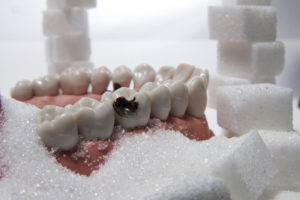
Sugar and Your Teeth
Did you know that sugar is one of the worst substances for your teeth? Your tooth enamel and sugar does not mix well. In fact, sugar actually attacks your teeth in a way. Sugar is found in most foods and drinks that people consume. When you eat, that sugar dissolves and mixes with bacteria in your mouth. That mixture forms a sticky, transparent substance that sticks to your teeth like glue. We like to called this substance plaque, and you might even have some on your teeth right now if you look closely.
The more sugar you eat, the more plaque your mouth will make. Even though plaque is clear, it is acidic in nature. When it coats your teeth, it starts to erode away your tooth enamel. That’s why sugar is such a concern when it comes to your oral health, and why dentists are always recommending patients to limit their sugar intake. More sugar means more plaque, which means more cavities for you. If you start to cut out sugar from your diet, or your child’s you may notice that your child will start to have fewer minor health problems and fewer cavities. If children and adults alike limit the sugar they consume while they have braces, they are much less likely to have eroded or decayed teeth when they get their braces off. Plaque already sticks to the teeth like crazy without braces. With them, it sticks even more and gets into the brackets as well.

Sugar Guidelines for Your Age Group
Did you know that there are sugar guidelines for how much sugar you should eat in a day? Those sugar guidelines don’t only come from a dentist, but countless health institutions. The National Institute of Health and the American Heart Association report that too many people are over-exceeding their daily sugar recommendation by more than double! Men should only be having up to 9 teaspoons of sugar a day, which is about 36 total grams of sugar or 150 calories. Women should only have up to 6 teaspoons, or 25 grams or 100 calories. Children should have little to no sugar and should consume well below 6 grams of added sugars a day.
However, studies show that many people over 18 are consuming an average of 34 grams of sugar a day. Children over 6 are getting 20 grams or more of added sugar a day and even babies 1-3 years old are getting 12 grams or more. It’s no wonder that the NIH reports that tooth decay (known as “cavities”) is the most chronic prevalent disease among children and adults!
Combat Tooth Decay During Braces
You want to be incredibly vigilant with taking care of your oral health, especially with braces. Brush and floss your teeth several times a day. We recommend brushing your teeth after every single meal to get rid of acidic plaque and food particles that get stuck so easily in brackets. Don’t forget to floss your teeth. Use floss threaders to make this part of cleaning your braces easier. Cleaning your teeth only takes a few minutes a day (even with braces) and it’s never something you want to skip.
You’re spending 18-24 months straightening your teeth. You don’t want that beautiful smile to be full of areas of tooth decay and tooth erosion when your braces come off. If you want a beautiful smile, follow the recommended sugar guidelines for your age group. Brush and floss your teeth meticulously and take care of your oral health. If you need help making cleaning your braces easier, call our Belmar Orthodontics office anytime at (303) 225-9016!
Are Your Teeth Cleaning Habits Good Enough?
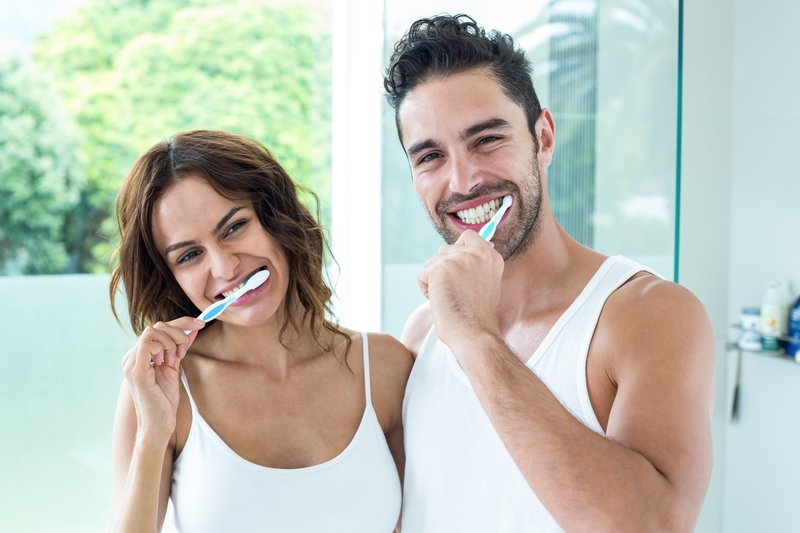
Braces can keep your teeth straighter, making them more beautiful and attractive. However, if your teeth cleaning habits are poor, your smile will take a hit. How well you take care of your teeth before and during braces will be an indication of how your smile will be after your orthodontic care has come to an end. If you don’t brush and floss the teeth enough, you might damage your smile and weaken your enamel. You must step up your cleaning routine during braces to make sure your smile isn’t full of cavities and oral health problems at the end of your care. We can give you the proper recommendations and guidelines to ensure you keep your smile healthy and strong during your time with braces and throughout life.
Brushing With and Without Braces
The American Dental Association recommends brushing and flossing the teeth at least twice a day to keep your mouth healthy and to lower your risk for tooth decay and gum disease. We go beyond that twice-a-day recommendation and suggest that you brush your teeth after every meal. Because your braces can easily attract and trap food particles, brushing after each meal can help prevent staining and reduce the potential for bacteria buildup.
You should use a soft-bristled brush and use one that’s size fits your mouth well. For teeth without braces, the ADA recommends brushing the teeth at a 45 degree angle. Brush each individual tooth, making sure to go all the way up to the gumline. You use a soft-bristled brush to avoid irritating the gums and eroding your tooth enamel. With braces, you want to brush down from the top, then up from the bottom on each tooth with a bracket. This will help dislodge food particles that have become trapped inside the brackets, which is extremely easy to do. Brushing your teeth multiple times a day is one of the best cleaning habits for avoiding decay.
Flossing the Teeth
We recommend flossing your teeth at least once a day. However, that’s for patients that don’t have braces. When you have braces, it’s even more important to floss each and every tooth. It’s also much more time consuming, but the effort you put into your teeth cleaning habits will pay off in the long run. A toothbrush and mouthwash simply can’t get in between the teeth like floss can, so if you skip flossing, you could have food sit and decay your teeth.
You will have to use threadable floss or a floss threader to accomplish this feat with brackets. If you use a floss threader for your teeth, think of your cleaning habits like you’re sewing. You floss the eye of the threader through your teeth and below the archwire. Then you floss the space, pull it out and thread once more. Make sure you don’t apply force or pressure against the archwire as you do this. For some patients, it may take about 10 minutes to floss, but it’s worth taking the time to avoid tooth decay.
Caring for Braces
Caring for your teeth becomes trickier with braces. You will find that you have to devote some extra time to caring for your braces, as you know have about 32 teeth that all have brackets that can collect food. During your time with braces, it is particularly important to maintain good oral health through attention to proper oral hygiene and cleaning habits. If you don’t, you could have your braces removed only to find that many of your teeth have areas of tooth decay. You could also be left with demineralization that leaves marks on all your teeth where the brackets were.
When it comes to caring for your braces, it’s not only important to clear away food particles that are on the teeth, but to be careful of what foods you put into your mouth. To avoid damage to your braces and your teeth during orthodontic treatment, you want to avoid hard foods, sticky foods, and foods high in sugar. This means you should avoid eating foods such as hard candy, chips, ice, apples, nuts, popcorn, carrots, corn on the cob, gum, caramel, taffy, licorice, gummies, and similar foods. Prevention is always key for avoid oral health issues!
Proper Teeth Cleaning Habits
If you’re going to spend 18-24 months straightening your teeth, you might as well keep those teeth healthy so they look nice at the end of your treatment. Brush your teeth every single day, multiple times a day. Floss as well and be meticulous with your cleaning habits. The better care you take of your braces while they’re on, the more you’ll enjoy your smile when they come off. If you would like help with your cleaning habits or tips, call our Belmar Orthodontics office today at (303) 225-9016!

